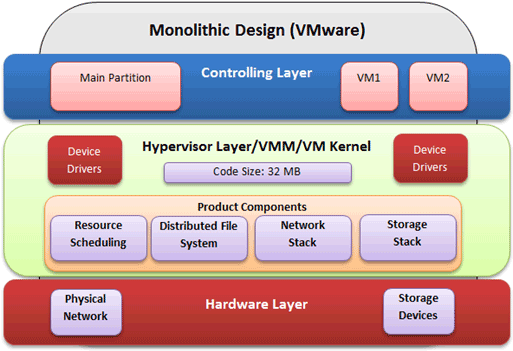

At the same time, there are a few disadvantages associated with the Microkernelized Hypervisor Design that are important to highlight:
As part of the security updates, the Operating System will be rebooted, which in turn requires you to take all virtual machines offline — or move to another node in the cluster without any downtime with the help of Hyper-V Live Migration feature.
As you can see in below figure, VMware’s vSphere uses the Monolithic Hypervisor Design, which requires the hypervisor-aware device drivers to be hosted in and managed by the “Hypervisor Layer.” This is what we see in the “Hypervisor Layer” in the below diagram; the device drivers are part of it:
Hypervisor device drivers must be developed and included in the “Hypervisor Layer” before you can start using the vSphere virtualization product. You cannot run VMware vSphere on hardware that is unsupported.
VMware vSphere operates its components in the “Hypervisor Layer” as shown in the above figure. Product components that it operates are Resource Scheduling, Distributed File System, etc. The Network Stack component, which is responsible for implementing the VMware networking, also operates in the “Hypervisor Layer.” The Storage Stack component allows “Controlling Layer” components to access storage devices.

The Monolithic Hypervisor Design provides the following advantages:
Disadvantages of Monolithic Hypervisor Design:
In the article we discussed how Microsoft Hyper-V and VMware vSphere operate differently from each other. We explored how each of the virtualization products uses a different virtualization architecture: Microkernelized Hypervisor Design for Microsoft Hyper-V and Monolithic Hypervisor Design for VMware vSphere.
We also covered some of the primary advantages and disadvantages each virtualization product offers, which IT workers or organizations should find valuable when determining the best virtualization product for implementation in their production environment.
Nirmal Sharma is a MCSEx3, MCITP and Microsoft MVP in Directory Services. He has specialized in Microsoft Technologies since 1994 and has followed the progression of Microsoft Operating System and software. In his spare time, he likes to help others and share some of his knowledge by writing tips and articles on various sites and contributing to Solution IDs for www.Dynamic-SpotAction.com.Nirmal can be reached at nirmal_sharma@mvps.org.
Property of TechnologyAdvice. © 2025 TechnologyAdvice. All Rights Reserved
Advertiser Disclosure: Some of the products that appear on this site are from companies from which TechnologyAdvice receives compensation. This compensation may impact how and where products appear on this site including, for example, the order in which they appear. TechnologyAdvice does not include all companies or all types of products available in the marketplace.